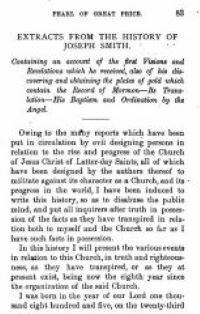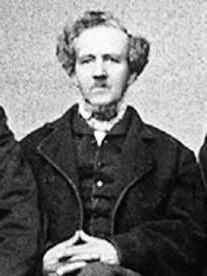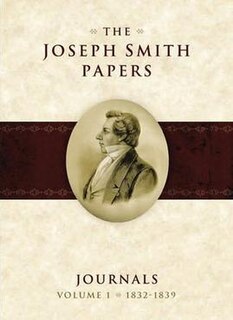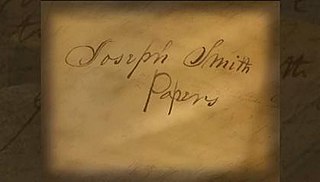Related Research Articles

The Latter Day Saint movement is the collection of independent church groups that trace their origins to a Christian Restorationist movement founded by Joseph Smith in the late 1820s.

The Church of Christ was the original name of the Latter Day Saint church founded by Joseph Smith. Organized informally in 1829 in New York and then formally on April 6, 1830, it was the first organization to implement the principles found in Smith's newly published Book of Mormon, and thus its establishment represents the formal beginning of the Latter Day Saint movement. Later names for this organization included the Church of the Latter Day Saints, the Church of Jesus Christ, the Church of God, the Church of Christ of Latter Day Saints, and the Church of Jesus Christ of Latter Day Saints.

Brigham Henry Roberts was a historian, politician, and leader in The Church of Jesus Christ of Latter-day Saints. He edited a popular six-volume history of the LDS Church and also wrote Studies of the Book of Mormon—published posthumously—which discussed the validity of the Book of Mormon as an ancient record. Roberts was denied a seat as a member of United States Congress because of his practice of polygamy.

Joseph Smith–History is a book in the Pearl of Great Price containing excerpts from an autobiographical record of some of the early events in the life of Joseph Smith, the founder of the Latter Day Saint movement. Like many of Smith's publications, it was dictated to scribes.

There are many works relating to Joseph Smith. These works cover Joseph Smith's his life, legacy, and teachings. Smith is the author of several works of scripture, and several personal histories, letters, and other writings. There have also been several biographies written about him.
In the Latter Day Saint movement, the Quorum of the Twelve is one of the governing bodies or (quorums) of the church hierarchy organized by the movement's founder Joseph Smith, and patterned after the Apostles of Jesus. Members are called Apostles, with a special calling to be evangelistic ambassadors to the world.
A Comprehensive History of The Church of Jesus Christ of Latter-day Saints: Century I is a six-volume history published in 1930 by B.H. Roberts, a general authority and Assistant Church Historian of the LDS Church. It should not be confused with the seven-volume History of the Church of Jesus Christ of Latter-day Saints, which was also edited by Roberts in the early 20th-century but focuses on the history of Joseph Smith.

Teachings of the Prophet Joseph Smith is a book compiling selected sermons and portions of sermons and sundry teachings of Joseph Smith, the first prophet of the Church of Jesus Christ of Latter Day Saints.
Mormons have both used and been subjected to significant violence throughout much of the religion's history. In the early history of the United States, violence was used as a form of control. Many people of different faiths used violence in order to harass and persecute people who adhered to different religious beliefs. Mormons were violently persecuted and pushed from Ohio to Missouri, from Missouri to Illinois and from Illinois, they were pushed west to the Utah Territory. There were incidents of massacre, home burning and pillaging, followed by the death of their prophet, Joseph Smith. Smith died from multiple gunshot wounds in a gun battle while jailed in Carthage; Smith defended himself with a small pistol smuggled to him by Cyrus Wheelock while trying to protect himself against a mob. There were also notable incidents in which Mormons perpetrated violence. Under the direction of Mormon prophets and apostles, the Mormon burned and looted Davies County, attacked and killed members of the Missouri state militia, and carried out an extermination order on the Timpanogos. Other Mormon leaders led the Mountain Meadows Massacre, Battle Creek massacre, and Circleville Massacre. Mormons have also been a major part in several wars, including the 1838 Mormon War, Walker War and Black Hawk War.

Phineas Howe Young was a prominent early convert in the Latter Day Saint movement and was later a Mormon pioneer and a missionary for The Church of Jesus Christ of Latter-day Saints. Phineas Young was an older brother of Brigham Young, who was the president of the LDS Church and the first governor of the Territory of Utah.
Sylvester Marshall Smith was an early leader in the Latter Day Saint movement and one of the inaugural seven Presidents of the Seventy.

The Joseph Smith Papers is a project researching, collecting, and publishing all manuscripts and documents created by, or under the direction of, Joseph Smith (1805-1844), the founder of the Latter Day Saint movement. The documents, which include transcriptions and annotations, have appeared both online and in printed form. The Church History Department of The Church of Jesus Christ of Latter-day Saints sponsors the project; the department's imprint, the Church Historian's Press, publishes the website and the printed volumes.

Alexander Neibaur was the first dentist to practice in Utah and first Jew to join the Latter Day Saint movement. He was educated for the profession at the University of Berlin and was a skilled dentist before the establishment of dental schools in America. He was fluent in 7 languages and as many dialects.
Dean Cornell Jessee is a historian of the early Latter Day Saint movement and leading expert on the writings of Joseph Smith Jr.
In the theology of the Latter Day Saint movement, an endowment refers to a gift of "power from on high", typically associated with Latter Day Saint temples. The purpose and meaning of the endowment varied during the life of movement founder Joseph Smith. The term has referred to many such gifts of heavenly power, including the confirmation ritual, the institution of the High Priesthood in 1831, events and rituals occurring in the Kirtland Temple in the mid-1830s, and an elaborate ritual performed in the Nauvoo Temple in the 1840s.

The Joseph Smith Papers: Television Documentary Series is a documentary television series produced by Ronald O. Barney and the Larry H. Miller Communications Corporation. The series documented the creation of, and work involved in, the Joseph Smith Papers Project. It also discussed the history of Joseph Smith, the founder and first prophet of The Church of Jesus Christ of Latter-day Saints, as well as the early history of the Latter Day Saint movement.
This is a bibliography of works on the Latter Day Saint movement.
References
- Jessee, Dean C. (1976), "The Reliability of Joseph Smith's History", Journal of Mormon History , 3: 23–46.
- Roberts, B. H., ed. (1902), History of the Church of Jesus Christ of Latter-day Saints, 1, Salt Lake City: Deseret News, OCLC 4890306 .
- Roberts, B. H., ed. (1904), History of the Church of Jesus Christ of Latter-day Saints, 2, Salt Lake City: Deseret News .
- Roberts, B. H., ed. (1905), History of the Church of Jesus Christ of Latter-day Saints, 3, Salt Lake City: Deseret News .
- Roberts, B. H., ed. (1908), History of the Church of Jesus Christ of Latter-day Saints, 4, Salt Lake City: Deseret News .
- Roberts, B. H., ed. (1909), History of the Church of Jesus Christ of Latter-day Saints, 5, Salt Lake City: Deseret News .
- Roberts, B. H., ed. (1912), History of the Church of Jesus Christ of Latter-day Saints, 6, Salt Lake City: Deseret News .
- Roberts, B. H., ed. (1932), History of the Church of Jesus Christ of Latter-day Saints, 7, Salt Lake City: Deseret News .